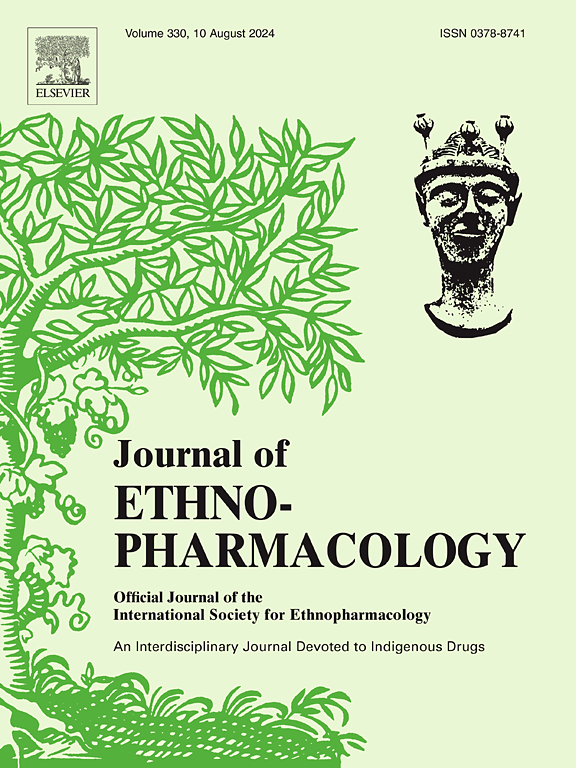The evaluation of the anti-inflammatory effects of Acorus calamus L. ethanolic extract on ovalbumin-induced allergic asthma in mice
IF 4.8
2区 医学
Q1 CHEMISTRY, MEDICINAL
引用次数: 0
Abstract
Ethnopharmacological relevance
Asthma is a protracted respiratory condition typified by inflammation of the airways, increased bronchial reactivity, and recurrent episodes of wheezing and breathlessness. Stimulation of immune cells in the airways releases inflammatory mediators such as histamine, leukotrienes, and cytokines, leading to bronchoconstriction, increased mucus production, and airway inflammation.
Aim of the study
Traditional medicine manuscripts mention that the rhizome extract of the Acorus calamus is beneficial for shortness of breath and cough. Recent studies have confirmed its antimicrobial, anti-inflammatory, and antioxidant properties. The research assessed the potential anti-inflammatory properties of the Acorus calamus in mice models of allergic asthma triggered by ovalbumin.
Materials and methods
The mice were sensitized on days 1, 14, and 21 to 23 with Ovalbumin (OVA). Dexamethasone (3 mg/kg) or Acorus calamus (50, 100, or 200 mg/kg) was administered by oral gavage on days 15–23. On day 25, Bronchoalveolar Lavage Fluid (BALF) and blood, and Lung tissue were collected.
Results
Treatment with Acorus calamus extract significantly decreased inflammatory cells (neutrophil, eosinophil, macrophage, lymphocyte) numbers and Interleukin-4 (IL-4) and levels in BALF and reduced total Immunoglobulin E (IgE) levels in serum and Nitric Oxide (NO) in lung tissue—also, significantly enhanced Interferon-γ (INF-γ) levels in BALF. Histological examination of the lung with Hematoxylin and Eosin, Periodic Acid-Schiff, and Trichrome Masson staining demonstrated that Acorus calamus significantly attenuated inflammatory cell infiltration and mucus-producing goblet cells in the lung.
Conclusion
The results indicate that Acorus calamus exerts anti-inflammatory effects in allergic asthma and may hold potential as an innovative treatment option for allergic bronchial asthma.

菖蒲醇提物对卵清蛋白致小鼠过敏性哮喘的抗炎作用
哮喘是一种以气道炎症、支气管反应性增加、反复发作的喘息和呼吸困难为特征的慢性呼吸系统疾病。刺激气道中的免疫细胞释放炎症介质,如组胺、白三烯和细胞因子,导致支气管收缩、粘液产生增加和气道炎症。传统医学文献中提到菖蒲根茎提取物对气短、咳嗽有一定的治疗作用。最近的研究证实了它的抗菌、抗炎和抗氧化特性。本研究评估了菖蒲对卵清蛋白诱发的过敏性哮喘小鼠模型的潜在抗炎特性。材料与方法卵清蛋白(OVA)致敏小鼠第1、14、21 ~ 23天。地塞米松(3 mg/kg)或菖蒲(50、100或200 mg/kg)于第15-23天灌胃。第25天采集支气管肺泡灌洗液(BALF)、血和肺组织。结果菖蒲提取物显著降低炎症细胞(中性粒细胞、嗜酸性粒细胞、巨噬细胞、淋巴细胞)数量和BALF中白细胞介素-4 (IL-4)及水平,降低血清中总免疫球蛋白E (IgE)水平和肺组织中一氧化氮(NO)水平,显著提高BALF中干扰素-γ (INF-γ)水平。苏木精、伊红、周期性酸希夫和三色马松染色对肺组织的组织学检查表明,菖蒲能显著减弱肺内炎症细胞浸润和产生黏液的杯状细胞。结论菖蒲对变应性支气管哮喘具有抗炎作用,有望成为变应性支气管哮喘的创新治疗方案。
本文章由计算机程序翻译,如有差异,请以英文原文为准。
求助全文
约1分钟内获得全文
求助全文
来源期刊

Journal of ethnopharmacology
医学-全科医学与补充医学
CiteScore
10.30
自引率
5.60%
发文量
967
审稿时长
77 days
期刊介绍:
The Journal of Ethnopharmacology is dedicated to the exchange of information and understandings about people''s use of plants, fungi, animals, microorganisms and minerals and their biological and pharmacological effects based on the principles established through international conventions. Early people confronted with illness and disease, discovered a wealth of useful therapeutic agents in the plant and animal kingdoms. The empirical knowledge of these medicinal substances and their toxic potential was passed on by oral tradition and sometimes recorded in herbals and other texts on materia medica. Many valuable drugs of today (e.g., atropine, ephedrine, tubocurarine, digoxin, reserpine) came into use through the study of indigenous remedies. Chemists continue to use plant-derived drugs (e.g., morphine, taxol, physostigmine, quinidine, emetine) as prototypes in their attempts to develop more effective and less toxic medicinals.
 求助内容:
求助内容: 应助结果提醒方式:
应助结果提醒方式:


